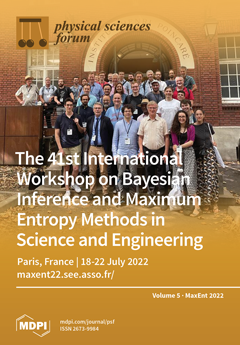The mass density, commonly denoted
as a function of position
and time
t, is considered an obvious concept in physics. It is, however, fundamentally dependent on the
continuum assumption, the ability of the observer
[...] Read more.
The mass density, commonly denoted
as a function of position
and time
t, is considered an obvious concept in physics. It is, however, fundamentally dependent on the
continuum assumption, the ability of the observer to downscale the mass of atoms present within a prescribed volume to the limit of an infinitesimal volume. In multiphase systems such as flow in porous media, the definition becomes critical, and has been addressed by taking the convolution
, involving integration of a local density
multiplied by a weighting function
over the small local volume
, where
is an expectation and
is a local coordinate. This weighting function is here formally identified as the probability density function
, enabling the construction of densities from probabilities. This insight is extended to a family of five probability densities derived from
, applicable to fluid elements of velocity
and position
at time
t in a fluid flow system. By convolution over a small geometric volume
and/or a small velocimetric domain
, these can be used to define five corresponding fluid densities. Three of these densities are functions of the fluid velocity, enabling a description of fluid flow of higher fidelity than that provided by
alone. Applying this set of densities within an extended form of the Reynolds transport theorem, it is possible to derive new families of integral conservation laws applicable to different parameter spaces, for the seven common conserved quantities (fluid mass, species mass, linear momentum, angular momentum, energy, charge and entropy). The findings considerably expand the set of known conservation laws for the analysis of physical systems.
Full article



